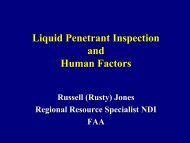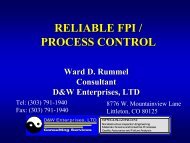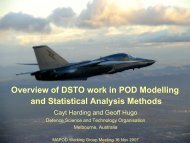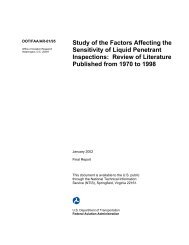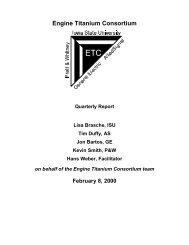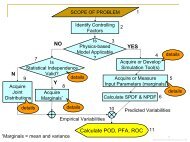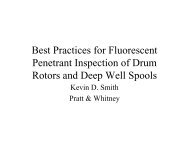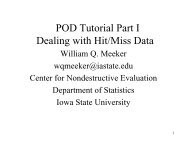Engine Titanium Consortium - Center for Nondestructive Evaluation ...
Engine Titanium Consortium - Center for Nondestructive Evaluation ...
Engine Titanium Consortium - Center for Nondestructive Evaluation ...
You also want an ePaper? Increase the reach of your titles
YUMPU automatically turns print PDFs into web optimized ePapers that Google loves.
Original<br />
Date<br />
Revised<br />
Date<br />
Description<br />
12/01 Complete combine Effects of Cleanliness Study<br />
and Cleanability & Drying Studies and generate<br />
matrix.<br />
Status<br />
Drying studies completed 6/01;<br />
cleaning study complete 2/02<br />
12/01 Initiate best practices document. Final report in progress. Draft to<br />
FAA 7/02.<br />
2/02 Complete best practices document and provide<br />
recommendations <strong>for</strong> further study.<br />
Final report to FAA in 7/02.<br />
Milestone change summary from the Phase II Technical Proposal – Volume I, Task 2.2.3 dated July<br />
10, 1998.<br />
1.) The industry workshop, month 3 (May 2000) milestone was changed in the February 8 kick-off<br />
meeting to a status update to the ATA September 12 meeting in San Francisco. It was felt that<br />
a month 3 milestone could not provide any input that the OEM experts were not already aware<br />
of and also that the subtask had nothing to communicate to the engine overhaul shops at the<br />
time.<br />
2.) The experimental design, month 3 (May 2000) milestone was set back one month to June to<br />
review contaminates, determine cleaning methods and decide what cleaning methods would be<br />
per<strong>for</strong>med on which contaminate type. Until this was determined, the necessary crack samples<br />
could not be determined and so this also was set back one month.<br />
3.) The team decided that since the “Effect of Cleanliness Study” was very similar to the<br />
Cleanability and Drying Studies, and would at least require crack samples called <strong>for</strong> in this<br />
second study, that the studies be combined. The determination of how clean is clean must<br />
include not just surface cleaning, but crack cleanliness also.<br />
4.) Etching practices study will now be completed at the same time as the cleanability and drying<br />
studies since the sample rendered unusable in the cleanliness study can be and will be used <strong>for</strong><br />
the etching practice study.<br />
Deliverables:<br />
Guidance on an optimal process <strong>for</strong> local etching practices.<br />
Specimen sets as required.<br />
Matrices which define the cleaning effectivity vs. typical engine run hardware contaminants,<br />
detectability <strong>for</strong> various cleaning methods, and detectability <strong>for</strong> various drying methods.<br />
Best Practices Document that provides guidance to the OEMs and airlines and will allow <strong>for</strong> any<br />
necessary specification changes.<br />
Recommendations <strong>for</strong> further work such as a <strong>for</strong>mal POD study.<br />
Metrics:<br />
Improved cleaning and drying processes clearly defined <strong>for</strong> implementation by the industry as part<br />
of FPI used in inspection of critical rotating hardware.<br />
Quarterly Report – January 1, 2002 –March 31, 2002<br />
print date/time: 6/6/2002 - 8:39 AM – Page 84



